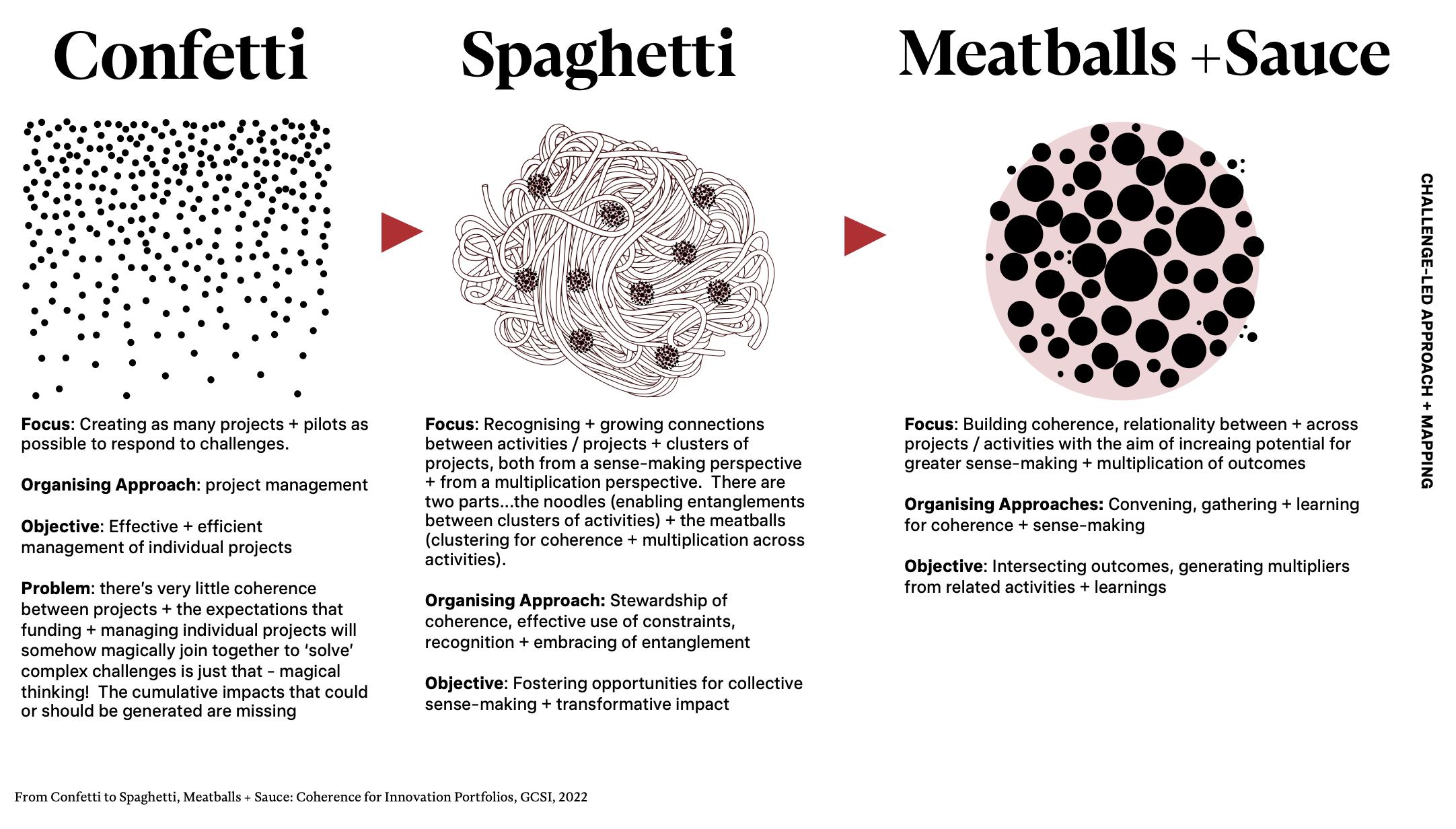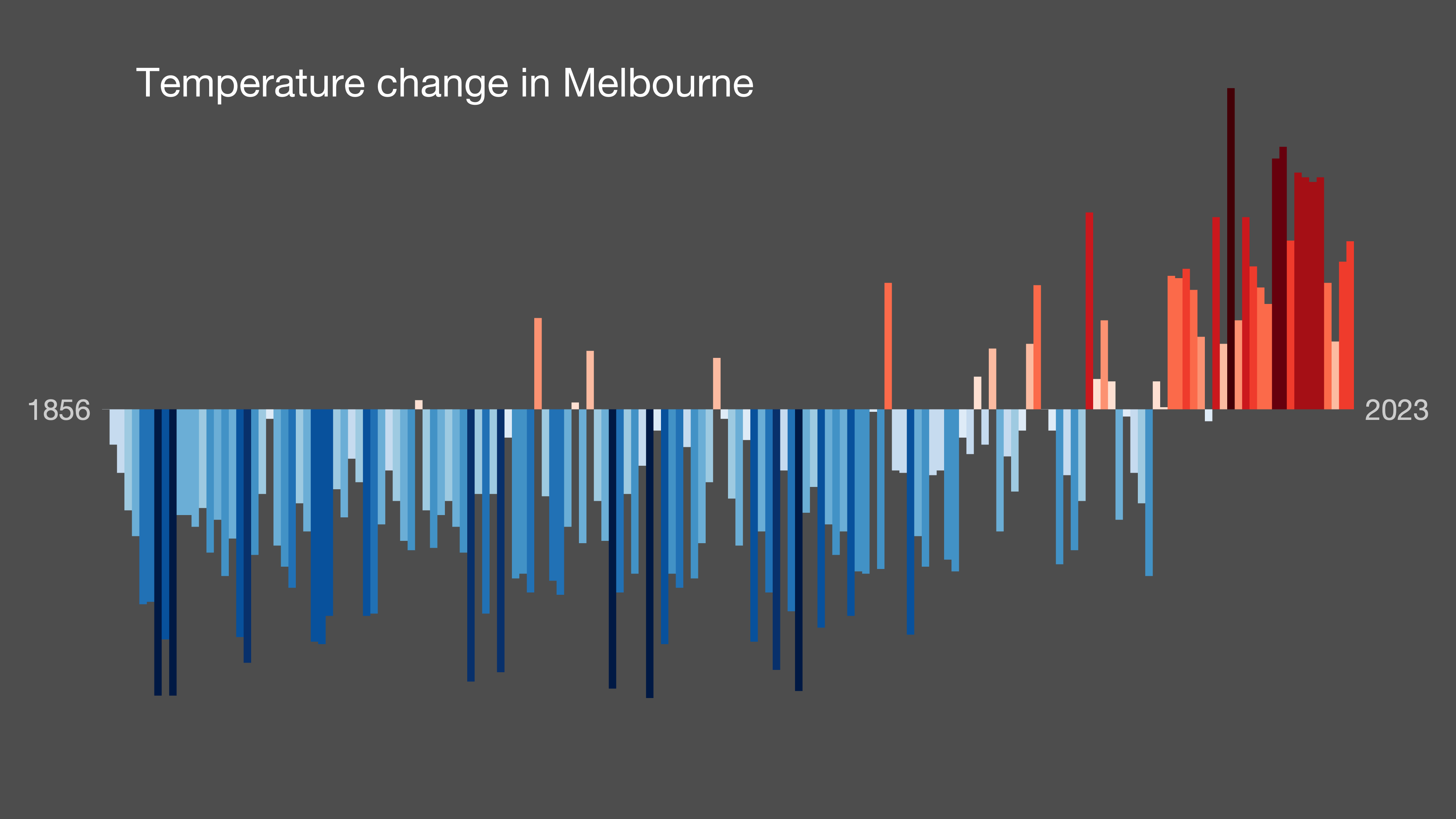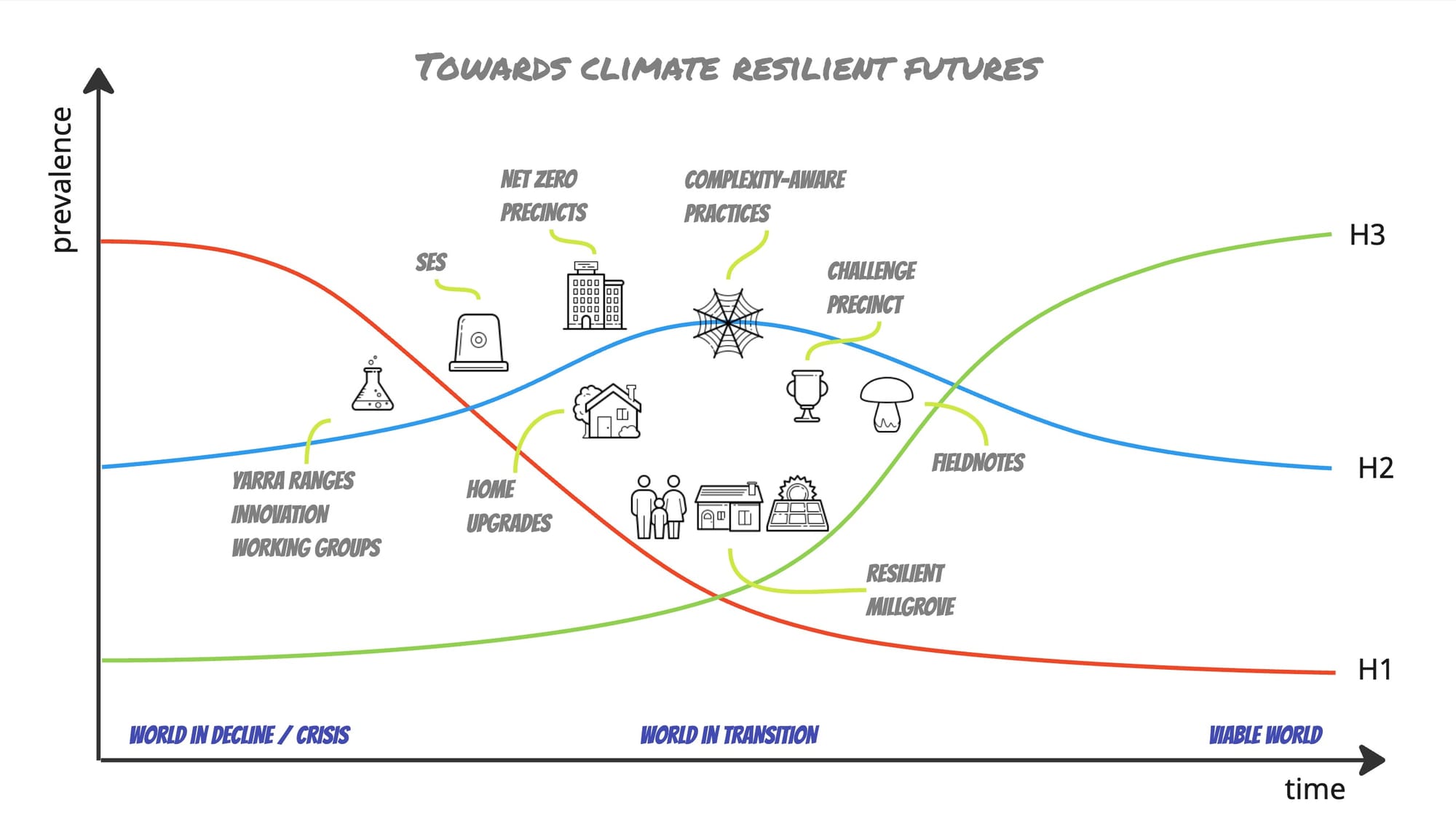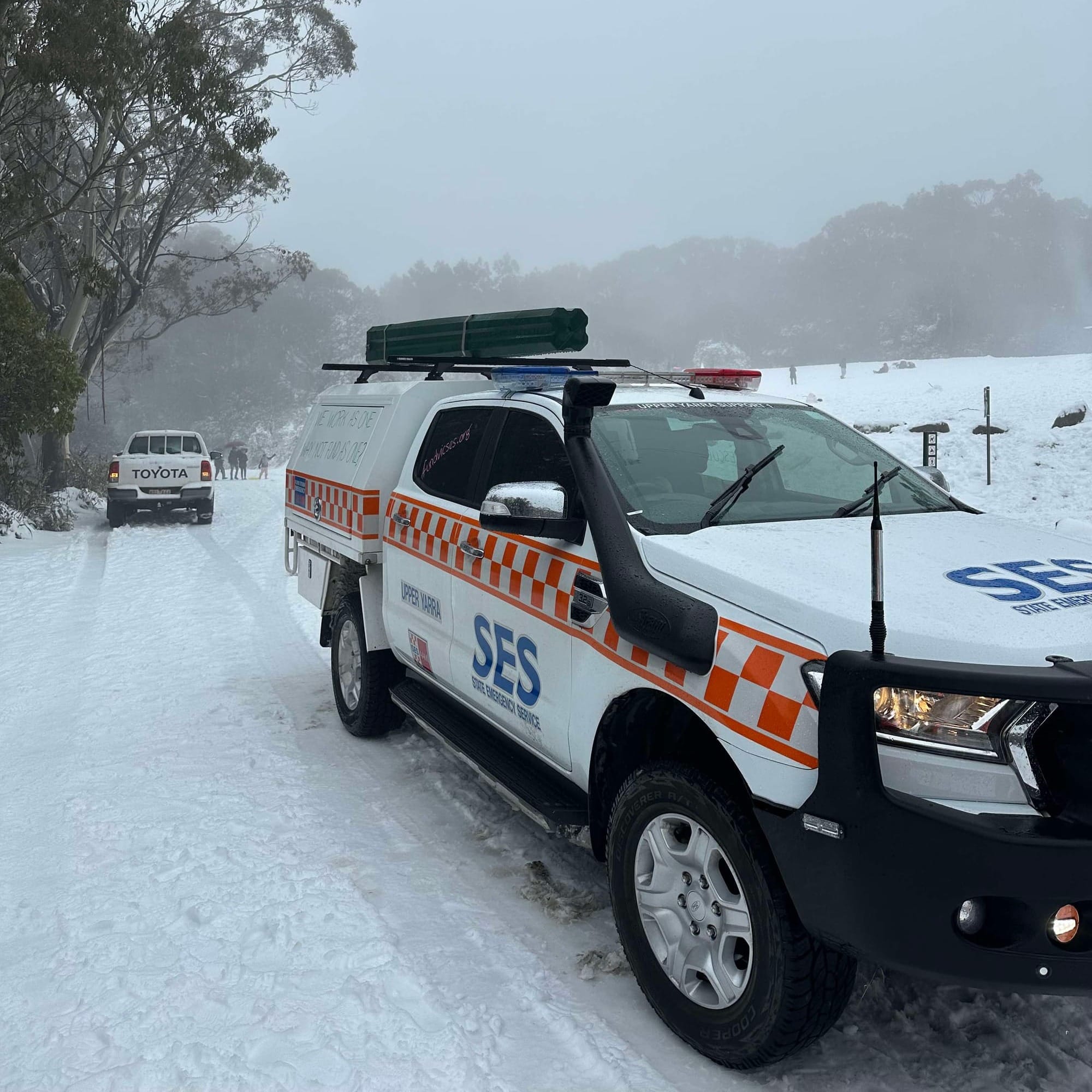Responding across the system
We need to address the complexity gap in climate responses.

To tackle complex challenges, we know we need to go from disjointed isolated responses, to coordinated multi-point strategies - or from confetti to spaghetti as Ingrid Burkett would say.

I was recently reflecting how I've found myself anchoring a foot in a number of spaces with work, volunteering and community work to understand and bridge across these worlds, to better respond to the current and future states of climate impacts.

I say 'climate impacts' because we're no longer talking about a future hypothesis - we're seeing the impacts now.
Fires, extreme weather, extreme heat - it's all already happening here in Australia and around the world. A quick check in with the climate stripes for Melbourne (above) shows us what we've brought about.

As I mentioned before, I realised I had a few plates spinning in work, volunteering and community life (not to mention parenting), so the other day I started mapping them out across the 3 horizon framework (Sharpe - nice resource from my friend Kate Goodwin on how to use it here), and realised that I cluster a lot of my work in the H2 area - bridging between unsustainable realities, and the emerging practices and systems (as many of us do).
Home Level
I wrote awhile back during covid about retrofitting our home in the Yarra Ranges and building social resilience in our immediate neighbourhood. Some of this has progressed, and some of it has fallen by the way side as the new role at Monash ramped up.

I believe this has benefits across short and medium time horizons, but it's very small and localised impact. We're mighty close to a net zero home across the year (net export in summer, and ~20% self produced energy in winter), but getting off gas entirely is tricky.
Neighbourhood Level
I've started doing a bit of community work with my local residents group to build on their great work with ResilientCo and Minderoo to create Resilient Millgrove.

I've been exploring opportunities to connect both Emergency Management and Community Resilience agendas through a Resilience & Emergency Hub - combining renewable & resilience energy infrastructure (solar, battery, hydrogen generator), built environment assets (community hall, place of last resort, council facilities) with programming that proactively builds social, economic and neighbourhood resilience.
Hopefully more about this soon.
I see this as a medium to longer term impact, bridging us from an unsustainable and high risk current reality towards a more resilient future. Impact is localised, but Resilient Millgrove has been used as a lighthouse site for other communities to learn from, so potentially there's outward ripples.
I've also been volunteering with the State Emergency Service (SES) which is essentially an organised response to storm events, road crash, and search & rescue.

This is about responding to a very different part of the system - it's emergency / crisis response work for the most part, with short term hyperlocalised impact (for our unit) and medium term capacity and capability for resilience.
In a different way, I also found myself involved in the Yarra Ranges Local Development Strategy work, which was launched in response to the closure of the Native Forestry industry in early 2024.
https://shaping.yarraranges.vic.gov.au/upper-yarra-local-development-strategy
In doing so, I was interested in a range of the themes which included abandoned buildings, biodiversity, mobility, renewable energy and more. There was a common sense that we're missing a key piece of community enablement - some kind of platform for community innovation stewarding and funding - perhaps like a community foundation?
The process is in the third phase now, which is a series of 'innovation working groups' which play a part of this role - identifying and supporting the development of proposals for these different thematics. I agreed to join the renewable energy and mobility groups, partially because my work is centered around these, but partially because I think they're critical for our region, and I'm interested to bring both a content lens (resilience, emergency preparedness, net zero etc) as well as a methodological lens (how do we build the platform for this to be a connected response which is in conversation with the other working groups).
Horizons: medium to longer term horizon, and potential for regionalised impact.
State - National - Global Level
When I look at my work with Monash University, this is a different scale of ambition but also a quite different mode.
The Net Zero Precincts work I'm involved in has fairly localised impact, focusing on the Clayton Campus and Monash Tech Precinct, but it's ambitions are to advance the net zero climate transition agenda by spreading the transition management approach and urban experimentation culture through documentation, publications, working with partner and allied organisations which include the likes of state government, local government, other research institutions and multi-national NGO.
https://www.monash.edu/msdi/initiatives/explore/projects/net-zero-precincts
Likewise the work I'm shaping up around a Challenge Precinct is looking at building directional collective action toward sustainable mobility systems in and around Clayton and Monash, building on the new Suburban Rail Loop going into the area. We're looking at how we build the systemic platform to foster an ecosystem of collaborative innovation in the precinct across business, government, research, civil society and community.
No link for this yet (although it's somewhat inspired by the idea of mission-oriented innovation districts and Vinnova's work), but watch this space.
Horizons: medium to longer term, with potential for significiant regional, state and potentially globalised impact.
Connected and Coherent
The horizons were one way to look at how I was approaching this, but it also got me thinking about the systems leverage canvas I shared during my Masters, which helped me to consider the connectedness and coherence of a portfolio of responses.
This helped me to think about my current array of initiatives, I feel there is relatively strong connectedness and coherence.
For me, there's a strong theme of working locally in the community space, across the crisis - preparedness - proactive resilience and innovation spectrum. I see myself building skills, building relationships and creating a connection to national and global conversations (and hopefully funding).
This localised perspective is also informing my work with Monash, where I'm engaged in the medium to longer term horizon work of building demonstrations (smaller and larger) of how collective action can be driven and what types of relational, physical and organisational infrastructures might be needed to train our sights on complex challenges and building momentum towards ambitious regenerative futures.
Perhaps they can all be categorised through Manzini's ideas of Small, Local, Open and Connected

Limitations and next steps
But let's be honest, I have limited time and energy. Any one of these areas could rapidly eat all of my capacity if I allowed it, and the majority of my working week goes towards Monash with everything else fit around it in evenings and weekends, which is also important family time.
But what I've described with my own attention, work, volunteering and community contribution is an example of the connected and coherent approaches I believe we need to see more of to address complex challenges.
The Challenge Precinct work is one of the areas I feel I have the greatest opportunity to realise this way of working at a greater scale - combining multiple sectors, multiple types of structured programming, and mobilising systemic investing as a way of achieving momentum, progress and positive impact across the different levels of society, in concert.
What other examples do you know of that bring together the different elements needed for effective collective action? Who does a good job of talking about the connectedness and coherence of their work? Drop me a comment to share?






